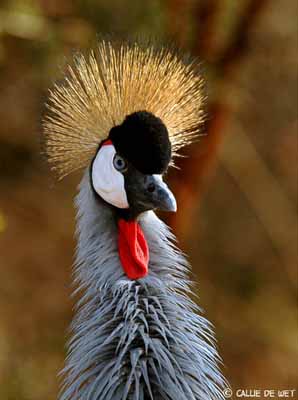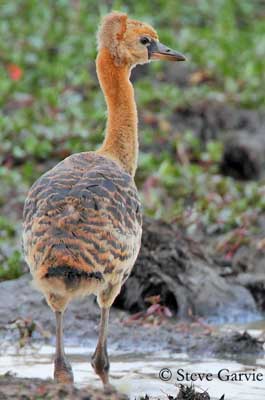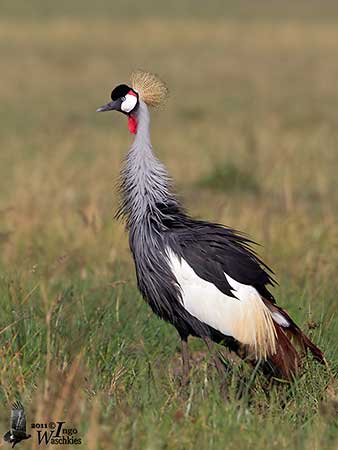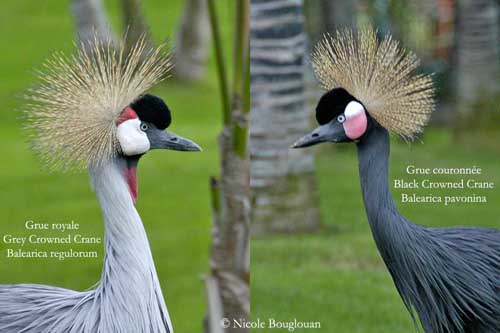
Fr: Grue royale
All : Südafrikanischer Kronenkranich
Esp: Grulla Coronada Cuelligrís
Ital: Gru coronata grigia
Nd: Grijze Kroonkraan
Sd: Grå krontrana
Photographers:
Steve Garvie
RAINBIRDER Photo galleries
Ken Havard
My Bird Gallery & Flickr gallery 1 & Flickr gallery 2
Tom Merigan
Tom Merigan’s Photo Galleries
Simon Tan
PBase Bird galleries
Ingo Waschkies
My bird pictures on Pbase
Callie de Wet
GALLERY
Philippe et Aline Wolfer
GALERIE
Nicole Bouglouan
PHOTOGRAPHIC RAMBLE
Texte de Nicole Bouglouan
Sources:
HANDBOOK OF THE BIRDS OF THE WORLD Volume 3 by Josep del Hoyo-Andrew Elliott-Jordi Sargatal - Lynx Edicions - ISBN : 8487334202
BIRDS OF AFRICA SOUTH OF THE SAHARA by Ian Sinclair and Peter Ryan - Princeton University Press Princeton and Oxford - ISBN: 0691118159
BirdLife International (BirdLife International)
International Crane Foundation
Wikipedia, the free encyclopedia
XENO-CANTO – Sharing Birds sounds from around the world
Grey Crowned Crane
Balearica regulorum
Gruiforme Order – Gruidae Family
BIOMETRIC:
Length: 100-110 cm
Wingspan: 180-200 cm
Weight: 3-4 kg
DESCRIPTION:
The Grey Crowned Crane is the traditional bird of Uganda. On the Coat of arms of this country, the subspecies B.r. gibbericeps appears on the right of the shield.
This crane is often confused with the very similar Black Crowned Crane (Balearica pavonina).
See below both species and their differences.

The Grey Crowned Crane is similar to the Black Crowned Crane, except the pale grey neck contrasting with the darker body.
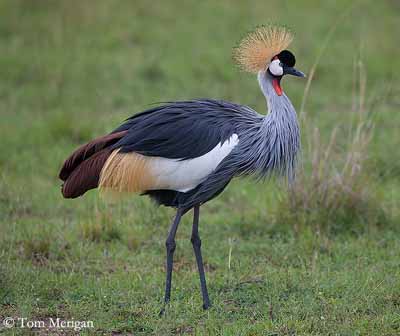
They slightly differ in head pattern. The Grey Crowned Crane has white cheek patch, with a small red patch only at top. The eyes are pale grey to pale blue. The red throat wattles or gular sacs are larger than in “pavonina”.
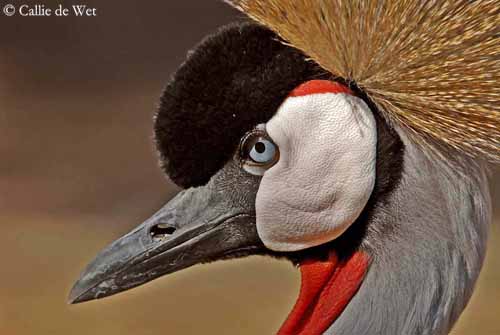
Both sexes are similar.
The juvenile is grey overall with brown crown and nape. The body is grey to brown. The eyes are brown. The cheeks are feathered.
The race B.r. gibbericeps shows more red on the white cheek patch.
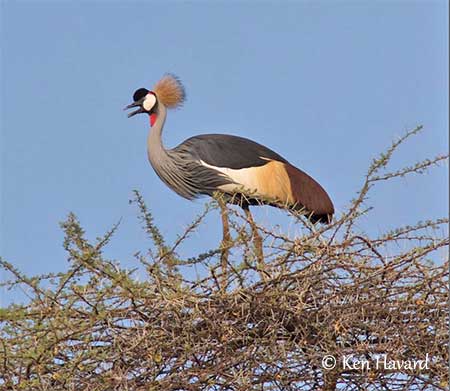
VOICE: SOUNDS BY XENO-CANTO
The Grey Crowned Crane utters trumpeting flight call “may hem” and low-pitched honks “huum huum” during the breeding season and the displays.
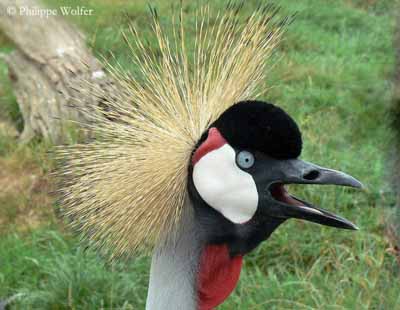
HABITAT:
The Grey Crowned Crane frequents wetlands and open grasslands, savannahs and cultivated areas.
In E Africa, this crane can be found in modified habitats such as pastures, croplands and irrigated areas.
In S Africa, it occurs in marshes, grasslands and savannahs, and cultivated fields.
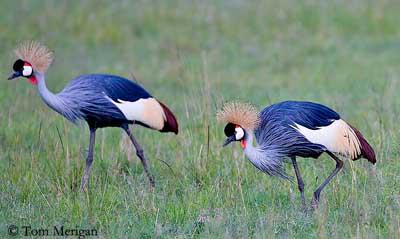
RANGE:
The Grey Crowned Crane is found in E and S Africa, from E Democratic Republic of Congo and Uganda, and Kenya to E South Africa.
BEHAVIOUR:
The Grey Crowned Crane forages in grassland and cultivated areas, giving rapid pecks to reach the food. This crane feeds on seed heads of sedges and the fresh parts of the grasses. It may uproot some plants, and sometimes stamps feet when searching for invertebrates and small preys such as insects, frogs and lizards on the ground.
This species can be seen following the cattle, probably benefiting from disturbed prey items.
The Grey Crowned Crane does not defend its feeding areas.
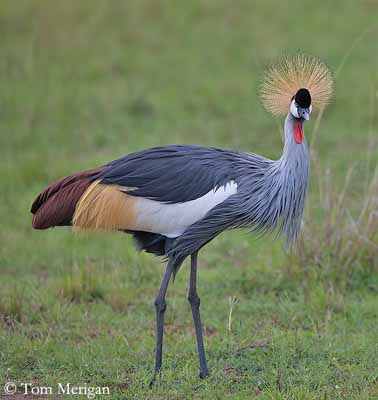
This species is gregarious outside the breeding season. They roost together in water or in trees, being with the Black Crowned Crane, the only cranes able to perch in trees thanks to the long hind toe which allows them to grasp the branches.
During the breeding season, the Grey Crowned Crane, as other Gruidae species, performs beautiful displays. They dance, bow, run and jump, while giving low booming calls involving the inflation of the gular sacs. These calls are given with the head lowered to shoulder level.
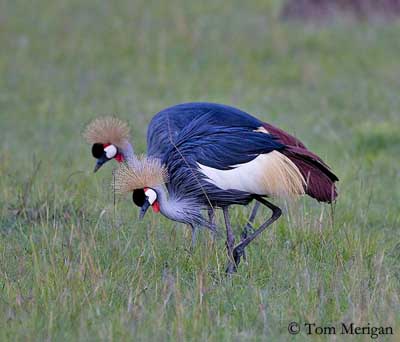
Then, the copulation occurs, and the cranes copulate repeatedly during several weeks before the laying.
Both sexes select the nest-site within the territory, and give unison calls from the site. They build the nest together.
These cranes may nest in trees, and sometimes use abandoned nests of large tree-nesting species, but this occurs rarely.
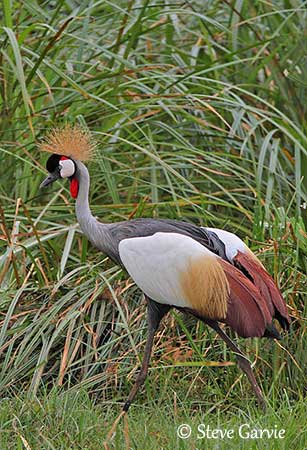
The Grey Crowned Crane is non-migratory, only performing local and seasonal movements according to the food resources, the nest-site availability and the rains.
These movements can be more important in the drier regions of the range.
FLIGHT:
The Grey Crowned Crane has powerful flight, but it has to run before to take flight. The wing beats are strong and steady, but it also uses thermals.
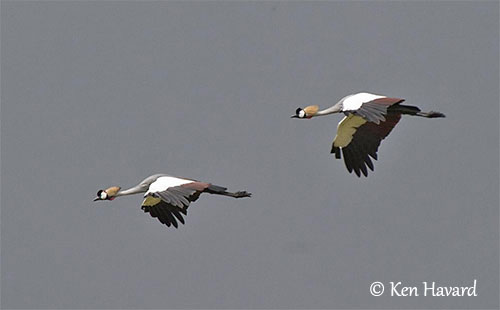
REPRODUCTION:
The breeding season varies according to the rains. This species breeds all year round in E Africa, and mainly during the drier periods, whereas on S Africa, it breeds mainly during the rainy season.
The nest is often placed along the wetland edges, rarely in tree. That is a circular platform made with uprooted grasses and flattened sedges to make the structure. The nest is hidden into the dense aquatic vegetation.
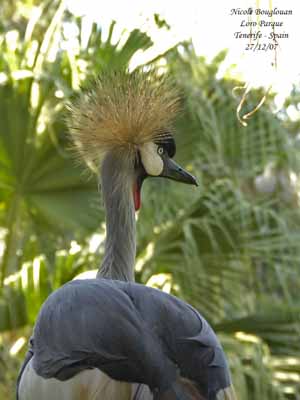
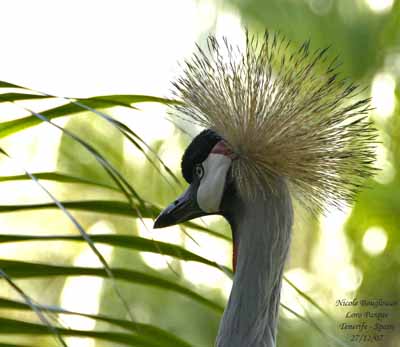
The female lays 1-4 eggs, but the clutch size may vary according to the elevation. The incubation by both sexes lasts about 50-60 days after hatching. They remain in family groups until the following breeding season. They are fed by both adults, and are sexually mature at 3 years.
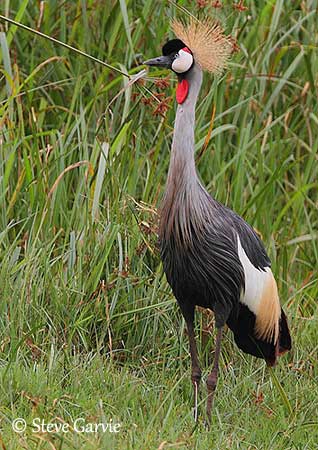
DIET:
The Grey Crowned Crane feeds on plant matter such as seed heads of sedges (Cyperus) and fresh parts of grasses. It also takes several types of insects such as grasshoppers, crickets, locusts, and worms, frogs, lizards and crabs.
PROTECTION / THREATS / STATUS:
The Grey Crowned Crane is the most abundant species of the African cranes, but declines occurred, due to degradation of the habitat by human developments, changes due to the drought in several regions, loss of the breeding areas due to drainage of wetlands and overgrazing, pet-trade, egg-collecting, hunting and use of pesticides.
This species is evaluated as VULNERABLE.
